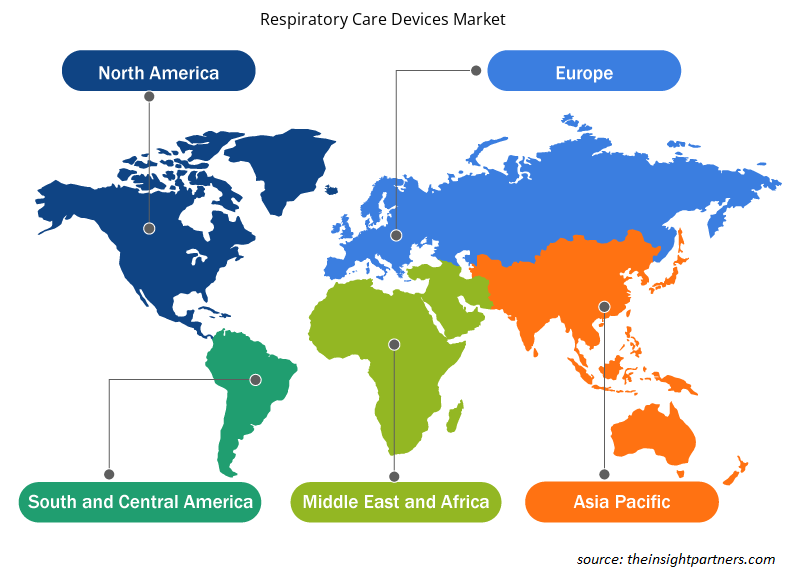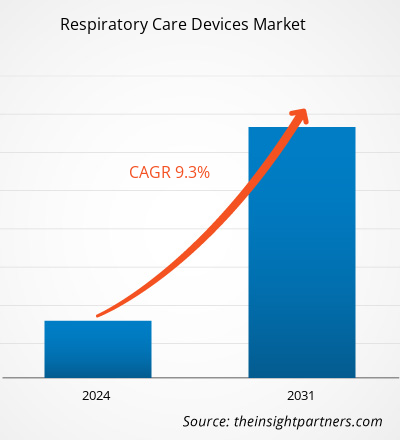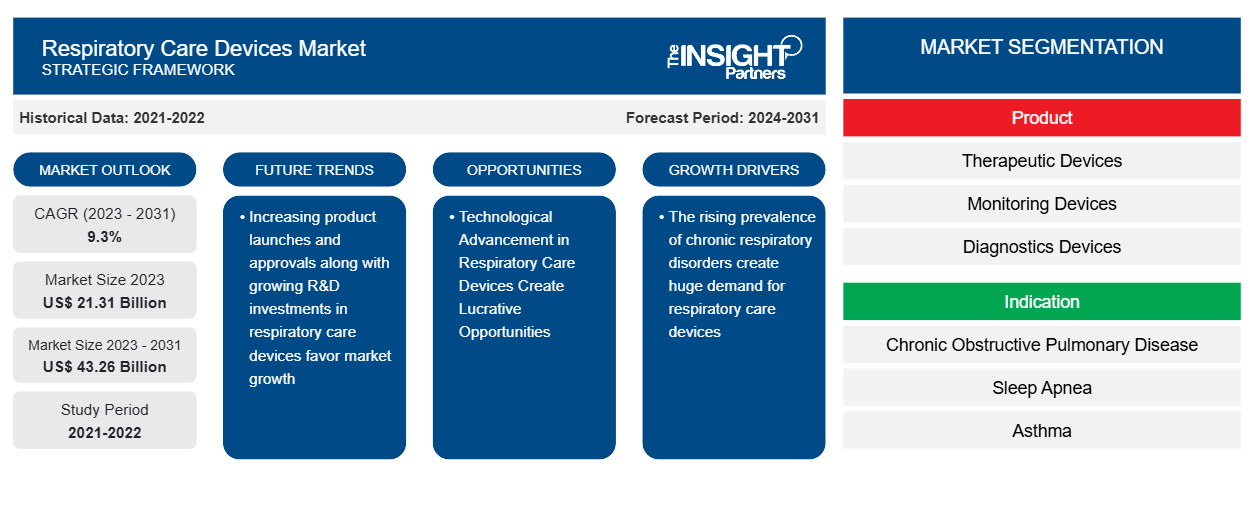Si prevede che il mercato dei dispositivi per la cura respiratoria raggiungerà i 43,26 miliardi di dollari entro il 2031, rispetto ai 21,31 miliardi di dollari del 2023. Si prevede che il mercato registrerà un CAGR del 9,3% nel periodo 2023-2031. La crescente adozione di dispositivi mobili/digitali per la cura respiratoria e il cambiamento di paradigma verso soluzioni tecnologiche basate sul valore rimarranno probabilmente tendenze chiave nel mercato.
Analisi di mercato dei dispositivi per la cura respiratoria
La crescente prevalenza di disturbi respiratori come BPCO, asma, influenza e altri e il crescente numero di lanci e approvazioni di prodotti insieme a investimenti sicuri in R&S nei dispositivi per la cura respiratoria sono i principali fattori che guidano la crescita del mercato dei dispositivi per la cura respiratoria. Inoltre, si prevede che la crescente domanda di dispositivi terapeutici hocare e il progresso tecnologico nei dispositivi per la cura respiratoria creeranno opportunità redditizie per la crescita del mercato. Inoltre, la crescente adozione di dispositivi mobili/digitali per la cura respiratoria e il cambiamento di paradigma verso soluzioni tecnologiche basate sul valore sono i fattori di tendenza che contribuiscono alla crescita del mercato.
Panoramica del mercato dei dispositivi per la cura respiratoria
Il mercato dei dispositivi per la cura respiratoria è guidato dalla crescente prevalenza di disturbi respiratori come BPCO, asma, influenza e altri e dal crescente numero di lanci e approvazioni di prodotti insieme a investimenti in ricerca e sviluppo sicuri nei dispositivi per la cura respiratoria. Inoltre, si prevede che la crescente domanda di dispositivi terapeutici per la cura delle vie respiratorie e il progresso tecnologico nei dispositivi per la cura delle vie respiratorie creeranno opportunità redditizie per la crescita del mercato. Il Nord America ha dominato il mercato dei dispositivi per la cura delle vie respiratorie e gli Stati Uniti guidano il mercato nordamericano. Durante la pandemia di COVID-19, la Food and Drug Administration (FDA) degli Stati Uniti ha intrapreso azioni significative per aumentare la disponibilità di apparecchiature respiratorie, tra cui ventilatori, pulsossimetri , concentratori di ossigeno e altri dispositivi e accessori. Tuttavia, si prevede che l'Asia Pacifica registrerà un tasso di crescita significativo a causa dei crescenti investimenti da parte di attori internazionali in Cina e India, del miglioramento del supporto governativo nei paesi, dell'aumento della popolazione geriatrica, dei crescenti livelli di inquinamento e del progresso delle infrastrutture sanitarie. Pertanto, la regione detiene un enorme potenziale per la crescita degli attori del mercato dei dispositivi per la cura delle vie respiratorie durante il periodo di previsione.
Personalizza questo report in base alle tue esigenze
Riceverai la personalizzazione gratuita di qualsiasi report, comprese parti di questo report, o analisi a livello nazionale, pacchetto dati Excel, oltre a usufruire di grandi offerte e sconti per start-up e università
-
Scopri le principali tendenze di mercato in questo rapporto.Questo campione GRATUITO includerà analisi di dati che spaziano dalle tendenze di mercato alle stime e alle previsioni.
Driver e opportunità di mercato per i dispositivi per la cura respiratoria
L'aumento della prevalenza delle malattie respiratorie infettive favorisce il mercato
Le malattie respiratorie infettive stanno creando un peso crescente sul sistema sanitario mondiale. Le malattie respiratorie infettive possono essere indotte da diversi fattori associati all'immunodeficienza. La maggior parte delle malattie respiratorie infettive si diffonde da persona a persona attraverso muco e saliva ed è causata da microrganismi che possono infettare il sistema respiratorio. La gravità delle malattie respiratorie contagiose varia da lieve a grave. Le malattie respiratorie infettive consistono in un elenco esaustivo di malattie, come tubercolosi (TB), COVID-19, influenza, difterite, morbillo, polmonite, pertosse, virus respiratorio sinciziale (RSV), ecc. Negli ultimi anni, il COVID-19 ha registrato il più alto tasso di mortalità a livello globale. Tra le malattie respiratorie infettive sopra menzionate, la TB era in cima alla lista per l'elevata prevalenza prima della pandemia di COVID-19. Ad esempio, secondo l'Organizzazione mondiale della sanità (OMS), la TB è la 13a causa di morte e la seconda malattia infettiva principale dopo il COVID-19. Nell'ottobre 2021, l'OMS ha dichiarato che nel 2022 circa 10,6 milioni di persone erano state infettate dalla tubercolosi in tutto il mondo, tra cui 5,8 milioni di uomini, 3,5 milioni di donne e 1,3 milioni di bambini.
Il progresso tecnologico nei dispositivi per la cura respiratoria crea opportunità redditizie
I progressi tecnologici semplificano la diagnosi da parte degli specialisti e l'automedicazione dei pazienti. Ad esempio, gli inalatori erogano quasi il 90% dei farmaci prescritti per le malattie respiratorie. Gli inalatori intelligenti sono lo strumento più recente per aiutare i pazienti con malattie respiratorie a ricevere i farmaci e a trasmettere informazioni vitali ai medici. Gli inalatori intelligenti sono dotati di tecnologia AI per raccogliere dati e monitorare le condizioni del paziente. La tecnologia è in fase di test per avvisare gli utenti di potenziali fattori scatenanti ambientali e per ricordare loro di assumere i farmaci in tempo. I medici e i clinici possono utilizzare i dati raccolti da questi inalatori intelligenti per comprendere meglio le esigenze di ogni paziente. Inoltre, i partecipanti al mercato possono concentrarsi sulle seguenti tendenze per sfruttare queste opportunità di crescita:
- Inalatore intelligente in grado di fornire feedback e supporto: le aziende farmaceutiche possono collaborare o stringere partnership con start-up innovative che offrono feedback in tempo reale sulla tecnica di inalazione e utilizzano la tecnologia acustica per la somministrazione del farmaco ai pazienti.
- Concentratori di ossigeno innovativi e durevoli: le aziende e gli innovatori del settore delle tecnologie sanitarie possono collaborare per esplorare opportunità di produzione di concentratori di ossigeno migliorati, stabili e facili da usare, per uso ospedaliero e domestico.
Analisi della segmentazione del rapporto di mercato sui dispositivi per la cura respiratoria
I segmenti chiave che hanno contribuito alla derivazione dell'analisi di mercato dei dispositivi per la terapia respiratoria sono il prodotto, l'indicazione e l'utente finale.
- In base al prodotto, il mercato dei dispositivi per la cura respiratoria è suddiviso in dispositivi terapeutici, dispositivi di monitoraggio, dispositivi diagnostici e materiali di consumo e accessori. I dispositivi terapeutici sono ulteriormente suddivisi in dispositivi a pressione positiva delle vie aeree (PAP), concentratori di ossigeno, ventilatori, inalatori, nebulizzatori, umidificatori e altri. Il segmento dei dispositivi terapeutici ha detenuto la quota di mercato maggiore nel 2023.
- Per indicazione, il mercato è segmentato in broncopneumopatia cronica ostruttiva neurogenerativa (BPCO), apnea notturna, asma, malattie infettive e altre. Il segmento della broncopneumopatia cronica ostruttiva (BPCO) ha detenuto la quota maggiore del mercato nel 2023.
- In termini di utente finale, il mercato è classificato in ospedali, assistenza domiciliare e assistenza ambulatoriale. Il segmento ospedaliero deteneva una quota significativa del mercato nel 2023.
Analisi della quota di mercato dei dispositivi per la cura respiratoria per area geografica
L'ambito geografico del rapporto di mercato sui dispositivi per la terapia respiratoria è suddiviso principalmente in cinque regioni: Nord America, Asia Pacifico, Europa, Medio Oriente e Africa, e Sud e Centro America.
Il Nord America ha dominato il mercato a causa della rapida diffusione del COVID-19, la crescente prevalenza di malattie polmonari ostruttive croniche (COPD) e asma, l'aumento della popolazione anziana e la crescente ricerca e sviluppo di dispositivi per la cura respiratoria sono alcuni dei principali fattori responsabili della spinta alla crescita del mercato. In Canada e Messico, è probabile che il mercato sperimenti opportunità di crescita a causa dei crescenti casi di disturbi respiratori e del continuo lancio di vari dispositivi per la cura respiratoria da parte di organizzazioni leader. Si prevede che l'Asia Pacifica crescerà con il CAGR più elevato nei prossimi anni.
Approfondimenti regionali sul mercato dei dispositivi per la cura respiratoria
Le tendenze regionali e i fattori che influenzano il mercato dei dispositivi per la cura respiratoria durante il periodo di previsione sono stati ampiamente spiegati dagli analisti di Insight Partners. Questa sezione discute anche i segmenti e la geografia del mercato dei dispositivi per la cura respiratoria in Nord America, Europa, Asia Pacifico, Medio Oriente e Africa e Sud e Centro America.

- Ottieni i dati specifici regionali per il mercato dei dispositivi per la cura respiratoria
Ambito del rapporto di mercato sui dispositivi per la cura respiratoria
| Attributo del report | Dettagli |
|---|---|
| Dimensioni del mercato nel 2023 | 21,31 miliardi di dollari USA |
| Dimensioni del mercato entro il 2031 | 43,26 miliardi di dollari USA |
| CAGR globale (2023-2031) | 9,3% |
| Dati storici | 2021-2022 |
| Periodo di previsione | 2024-2031 |
| Segmenti coperti |
Per Prodotto
|
| Regioni e Paesi coperti |
America del Nord
|
| Leader di mercato e profili aziendali chiave |
|
Densità degli attori del mercato dei dispositivi per la cura respiratoria: comprendere il suo impatto sulle dinamiche aziendali
Il mercato dei dispositivi per la cura respiratoria sta crescendo rapidamente, spinto dalla crescente domanda degli utenti finali dovuta a fattori quali l'evoluzione delle preferenze dei consumatori, i progressi tecnologici e una maggiore consapevolezza dei benefici del prodotto. Con l'aumento della domanda, le aziende stanno ampliando le loro offerte, innovando per soddisfare le esigenze dei consumatori e capitalizzando sulle tendenze emergenti, il che alimenta ulteriormente la crescita del mercato.
La densità degli operatori di mercato si riferisce alla distribuzione di aziende o società che operano in un particolare mercato o settore. Indica quanti concorrenti (operatori di mercato) sono presenti in un dato spazio di mercato in relazione alle sue dimensioni o al valore di mercato totale.
Le principali aziende che operano nel mercato dei dispositivi per la cura respiratoria sono:
- Koninklijke Philips NV
- ResMed Inc
- Medtronic
- Massimo
- THERMO FISHER SCIENTIFIC INC.
- Società per azioni Dragerwerk AG & Co. KGaA
Disclaimer : le aziende elencate sopra non sono classificate secondo un ordine particolare.

- Ottieni una panoramica dei principali attori del mercato dei dispositivi per la cura respiratoria
Notizie di mercato e sviluppi recenti sui dispositivi per la cura respiratoria
Il mercato dei dispositivi per la cura respiratoria viene valutato raccogliendo dati qualitativi e quantitativi dopo la ricerca primaria e secondaria, che include importanti pubblicazioni aziendali, dati di associazioni e database. Di seguito sono elencati alcuni degli sviluppi nel mercato dei dispositivi per la cura respiratoria:
- ResMed ha lanciato negli Stati Uniti i suoi dispositivi a pressione positiva bilevel delle vie aeree AirCurve 11. Utilizza la pressione positiva inspiratoria delle vie aeree (IPAP) e la pressione positiva espiratoria delle vie aeree (EPAP). In combinazione con la tecnologia digitale, AirCurve 11 è stato progettato per aiutare i fornitori a trattare l'apnea notturna mentre i pazienti iniziano e proseguono la terapia. (Fonte: ResMed, Newsletter, febbraio 2024)
- Getinge ha lanciato il suo ventilatore meccanico Servo-c in India. Il Servo-c è progettato per soddisfare le esigenze respiratorie dei pazienti, offrendo strumenti terapeutici di protezione polmonare. Attraverso questo lancio, l'azienda desidera rendere le soluzioni sanitarie accessibili e convenienti per gli ospedali in India. (Fonte: Getinge, Newsletter, febbraio 2024)
- Inspira Technologies OXY BHN Ltd. ha lanciato un kit monouso monouso per l'ossigenazione del sangue per la sua serie di dispositivi medici INSPIRA ART. Il kit è anche pensato per essere compatibile con vari altri macchinari di supporto vitale, attingendo al mercato dei sistemi di perfusione monouso. (Fonte: Inspira Technologies, comunicato stampa, gennaio 2024)
Copertura e risultati del rapporto di mercato sui dispositivi per la cura respiratoria
Il rapporto "Dimensioni e previsioni del mercato dei dispositivi per la cura respiratoria (2021-2031)" fornisce un'analisi dettagliata del mercato che copre le seguenti aree:
- Dimensioni e previsioni del mercato dei dispositivi per la cura respiratoria a livello globale, regionale e nazionale per tutti i principali segmenti di mercato coperti dall'ambito
- Tendenze del mercato dei dispositivi per la cura respiratoria e dinamiche di mercato come driver, sistemi di ritenuta e opportunità chiave
- Analisi dettagliata delle cinque forze PEST/Porter e SWOT
- Analisi di mercato dei dispositivi per la cura respiratoria che copre le principali tendenze di mercato, il quadro globale e regionale, i principali attori, le normative e i recenti sviluppi del mercato
- Analisi del panorama industriale e della concorrenza che copre la concentrazione del mercato, l'analisi della mappa di calore, i principali attori e gli sviluppi recenti per il mercato dei dispositivi per la cura respiratoria
- Profili aziendali dettagliati
- Analisi storica (2 anni), anno base, previsione (7 anni) con CAGR
- Analisi PEST e SWOT
- Valore/volume delle dimensioni del mercato - Globale, Regionale, Nazionale
- Industria e panorama competitivo
- Set di dati Excel
Report recenti
Testimonianze
Motivo dell'acquisto
- Processo decisionale informato
- Comprensione delle dinamiche di mercato
- Analisi competitiva
- Analisi dei clienti
- Previsioni di mercato
- Mitigazione del rischio
- Pianificazione strategica
- Giustificazione degli investimenti
- Identificazione dei mercati emergenti
- Miglioramento delle strategie di marketing
- Aumento dell'efficienza operativa
- Allineamento alle tendenze normative























 Ottieni un campione gratuito per - Mercato dei dispositivi per la cura respiratoria
Ottieni un campione gratuito per - Mercato dei dispositivi per la cura respiratoria